


TOKUGAWA IEYASU 1542 -
Acknowledgements
Ieyasu: by the Japanese artist Kano Tan’yu (1602-
Including:
Kabuki Theatre
and Rimpa School

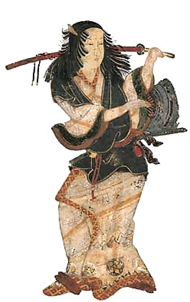 xxxxxIt was at this time that Kabuki, a composition of drama, music, song and dance, made its appearance in Japan. The letters that make up the word Kabuki (ka-
xxxxxIt was at this time that Kabuki, a composition of drama, music, song and dance, made its appearance in Japan. The letters that make up the word Kabuki (ka-
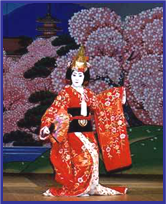 xxxxxIn the beginning, many of the dancers were women, but this was generally frowned upon, and from 1629 only men were permitted to take part. Productions were held in large theatres, often on extended stages, and, unlike Noh plays, the actors performed with painted faces (not masks), and the dance movements were less controlled and much faster in tempo. Plots were generally woven around traditional romances -
xxxxxIn the beginning, many of the dancers were women, but this was generally frowned upon, and from 1629 only men were permitted to take part. Productions were held in large theatres, often on extended stages, and, unlike Noh plays, the actors performed with painted faces (not masks), and the dance movements were less controlled and much faster in tempo. Plots were generally woven around traditional romances -
xxxxxMaking its appearance in Japan at this time was a composition of drama, music, song and dance known as Kabuki. It had its origin in Noh plays and folk dancing, and its spectacular costumes and settings, and its lively action made it extremely popular among the common people. At first plots were woven around traditional romances or based on domestic comedy or tragedy, but later historical events were dramatised and gangster plays were introduced. From 1629 only men were allowed to take part.
xxxxxAnother important event of this period was the founding of the school of highly decorative painting known as Rimpa. Onexof the principal founders was the calligrapher and tea master Hon’ami Koetsu 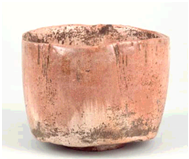 (1558-
(1558-
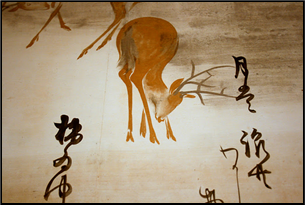 xxxxxHe is particularly remembered today for his part in reviving the traditional art of making poem scrolls. He produced these in collaboration with the brilliant painter Tawaraya Sotatsu, an artist famed for his screen paintings and fan pictures. Koetsu inscribed a classical poem on a scroll and Sotatsu richly decorated the paper with silver and gold designs of birds, flowers and deer. One of best examples of this combined craftsmanship is to be seen in the Deer Scroll, produced in the early years of the 17th century and now in the Seattle Arts Museum, Washington State, (detail shown here). Such superb workmanship in these fine arts was continued by a number of Japanese artisans, notably Ogata Kōrin (1658-
xxxxxHe is particularly remembered today for his part in reviving the traditional art of making poem scrolls. He produced these in collaboration with the brilliant painter Tawaraya Sotatsu, an artist famed for his screen paintings and fan pictures. Koetsu inscribed a classical poem on a scroll and Sotatsu richly decorated the paper with silver and gold designs of birds, flowers and deer. One of best examples of this combined craftsmanship is to be seen in the Deer Scroll, produced in the early years of the 17th century and now in the Seattle Arts Museum, Washington State, (detail shown here). Such superb workmanship in these fine arts was continued by a number of Japanese artisans, notably Ogata Kōrin (1658-
xxxxxAnd it was artists of this time that contributed to the building of the Tosho-
xxxxxIt was at this time that the Rimpa School of painting was founded, famed for its highly decorative artwork. A principal founder was the brilliant calligrapher Hon’ami Koetsu. He gathered around him a small colony of artisans specialising in lacquer ware, decorated paper and ceramics. In collaboration with other artists, he also became famous for his richly decorated poem scrolls -
xxxxxAs we have seen, from the beginning of the Onin War in 1467 (E4), Japan was gripped by years of civil strife. It was not really until 1603, when Tokugawa Ieyasu, the founder of the Tokugawa shogunate, came to power that the country entered a long period of peace and stability. He eliminated any opposition and imposed a rigid feudal system. Everyone knew their place and owed allegiance to the shogun, whilst Buddhist sects were used to educate and control the masses. At first he was prepared to tolerate Christians and European traders, but in 1612 he began the persecution of both, and this policy was continued by his successors. By 1650 all Christians had been killed or expelled, and only a few Dutch and Chinese traders were allowed to remain in Nagasaki. This isolationism developed a fiercely nationalistic and inward-
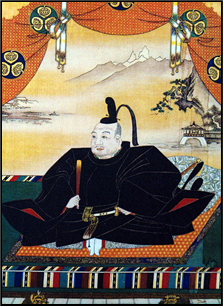 xxxxxAs we have seen, the Onin War which began in 1467 (E4), a violent conflict of eleven years, proved but the prelude to the "Epoch of the Warring Country", a century of fighting throughout Japan in which local feudal lords (or daimyo) battled with each other to gain control of their self-
xxxxxAs we have seen, the Onin War which began in 1467 (E4), a violent conflict of eleven years, proved but the prelude to the "Epoch of the Warring Country", a century of fighting throughout Japan in which local feudal lords (or daimyo) battled with each other to gain control of their self-
xxxxxFollowingxthe death of Hideyoshi in 1598, Ieyasu emerged as the most powerful military leader in Japan, having fought and schemed his way to prominence during the feudal wars of the past 40 years. Inx1600 he promptly defeated his rivals at the Battle of Sekigahara, and three years later in 1603, the Emperor (a leader in name only), appointed him shogun, the country's military governor. He immediately set about ensuring the long-
xxxxxHis first step was to impose a rigid feudal system, already introduced in part by Hideyoshi, and to add some unique features. Divisions were made on defined social lines, as one would expect, but the 300 or so feudal lords -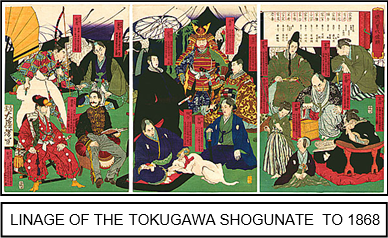 n, the Emperor and his court owed direct allegiance to the shogun, and the various Buddhist sects were used to educate and control the masses. This highly organized military-
n, the Emperor and his court owed direct allegiance to the shogun, and the various Buddhist sects were used to educate and control the masses. This highly organized military-
xxxxxOn first coming to power, Ieyasu welcomed European traders and tolerated Christian missionaries, and, save for one or two drastic exceptions, this had been the attitude of past rulers. However, by 1612 he had become convinced that the introduction of Christianity was a prelude to foreign conquest. Thexpersecution of the Christians -
xxxxxMeanwhile, from 1624 overseas traders were forbidden to land on Japanese soil, and within a few years the only point of contact with the outside world was with a small number of Chinese and Dutch traders permitted to stay at the port of Nagasaki. Even here, the Dutch were restricted to Deshima Island in the bay, and their activities were constantly being limited. This self-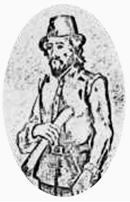 n American naval mission in the middle of the 19th century.
n American naval mission in the middle of the 19th century.
xxxxxIncidentally, William Adams (1564-
J1-


